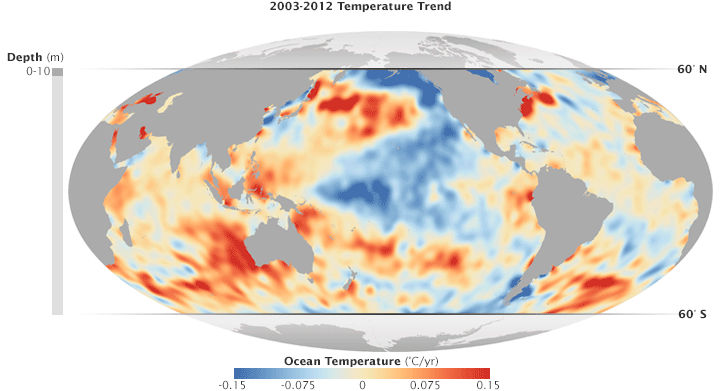General Discussion
Related: Editorials & Other Articles, Issue Forums, Alliance Forums, Region ForumsNew Study: Heat is Being Stored Beneath the Ocean Surface
For much of the past decade, a puzzle has been confounding the climate science community. Nearly all of the measurable indicators of global climate change—such as sea level, ice cover on land and sea, atmospheric carbon dioxide concentrations—show a world changing on short, medium, and long time scales. But for the better part of a decade, global surface temperatures appeared to level off. The overall, long-term trend was upward, but the climb was less steep from 2003–2012. Some scientists, the media, and climate contrarians began referring to it as “the hiatus.”

If greenhouse gases are still increasing and all other indicators show warming-related change, why wouldn’t surface temperatures keep climbing steadily, year after year? One of the leading explanations offered by scientists was that extra heat was being stored in the ocean.
Now a new analysis by three ocean scientists at NASA’s Jet Propulsion Laboratory not only confirms that the extra heat has been going into the ocean, but it shows where. According to research by Veronica Nieves, Josh Willis, and Bill Patzert, the waters of the Western Pacific and the Indian Ocean warmed significantly from 2003 to 2012. But the warming did not occur at the surface; it showed up below 10 meters (32 feet) in depth, and mostly between 100 to 300 meters (300 to 1,000 feet) below the sea surface. They published their results on July 9, 2015, in the journal Science.
“Overall, the ocean is still absorbing extra heat,” said Willis, an oceanographer at JPL. “But the top couple of layers of the ocean exchange heat easily and can keep it away from the surface for ten years or so because of natural cycles. In the long run, the planet is still warming.”
More at the Link:
http://earthobservatory.nasa.gov/IOTD/view.php?id=86184&src=eoa-iotd
ladjf
(17,320 posts)at the same time similar to geothermal. The entire generation operation would be done deep underwater for a variety of reason. The main is that by generating the energy by heat exchange, only the electricity would need to be transported. The generation machine would need to be mobile to continue moving into the uncooled warmer water.
Marty McGraw
(1,024 posts)to relieve all it's pent-up energy, it just creates hurricanes & Monsoons with. I wonder what affect the added moisture in the air can contribute to reflection of the sun's energy back into space.
I believe all man has done is speed up the natural earth cycle. Instead of what took 60,000 years now happens w/in 200. Just like what Fracking does when it lets go of what would have taken the earth hundreds of years to slowly release in just a matter of days. Way too much trauma all at once. Nothing in nature can adapt to that.
I also wonder if after all the scrubbing of species after the horror of an uncontainable heating. If the event of a snowball earth event comes about a lot sooner (threshold of too much reflection) and re contains (solidifies & traps) all the crap back into the earth. But once again, just a massive speed-up of the natural cycle. Interesting to think about
KamaAina
(78,249 posts)why hasn't anyone found a way to hook lightning rods up to batteries? Florida and Louisiana alone could power the whole continent!
Marty McGraw
(1,024 posts)After all this time since BenjiFran You would've thought we could have made some strides in this arena.
just another hurdle to get past the 'too much, all at once' phenomenon. Kinda' like sex from time to time
KamaAina
(78,249 posts)perhaps the new Tesla ones.
Marty McGraw
(1,024 posts)and/or the size of conduit / conductor needed to transport the sudden zap across from w/out melting the conductor in the process. I mean it takes the mass of the surrounding earth just to ground the damn stuff
KamaAina
(78,249 posts)Marty McGraw
(1,024 posts)Hey! There it is!
Thanks, your's is the first!
Good to be here!
again. ![]()
KamaAina
(78,249 posts)Marty McGraw
(1,024 posts)The damage from Carbon. That is Fantastic as well as prophetic! It all comes back to Heat dissipation rates!
KamaAina
(78,249 posts)Igel
(35,359 posts)There's a lot of buoyancy there, a lot of water for the counterequatorial current to slosh east.
NCjack
(10,279 posts)Marty McGraw
(1,024 posts)I think the traditional term of El Nino will no longer apply. It will be considered the new 'Normal Weather Pattern' before long and will have to come up with a new catch phrase for the new extreme shock spikes w/in that new cycle.
KamaAina
(78,249 posts)NightWatcher
(39,343 posts)Just kidding, I used to monitor the water temps on a daily basis as a part of my job monitoring for manatees and other marine endangered species. I noticed that the temps were warming earlier in the year and cooling later in the year and that was affecting migration patterns and where I needed to monitor.
I first noticed the changes in year to year temps in the Gulf near Mobile, but saw it too on the Atlantic side of Florida.
We're changing climate in ways we haven't put together yet, I'm afraid.
Marty McGraw
(1,024 posts)have you seen, or not seen, currently with species populations with the sea life since the big(ger) oil spill of yore. I'm sure it has been heart-breaking for you spending the amount of time you had devoted to your work.
BTW, Awesome SigLine!
I Love it!